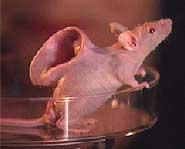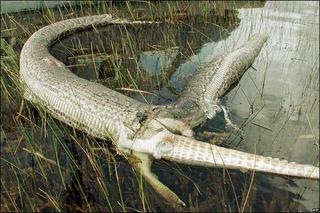| You Passed 8th Grade Math |
Congratulations, you got 10/10 correct! |
Sunday, October 23, 2005
Thursday, October 20, 2005
Environmental Science: Bioengineering

As mentioned in class: A mouse with a Human ear "growing" on it's back.
The following is text from an email explaining this image.
Forwarded-by: bostic@bsdi.com (Keith Bostic)
Forwarded-by: Todd Kover
BOSTON (AP) -- It sounds like something from a carnival side
show: ``The Mouse With A Human Ear On Its Back.'' But it's real.
It's alive.
That mouse, and others of its kind, are at the leading edge of a
science known as tissue engineering, which allows laboratories to
grow skin and cartilage for transplant in humans.
The mouse in question, in the laboratory of University of
Massachusetts anesthesiologist Dr. Charles Vacanti, is helping
researchers refine the technology that someday will allow them to
regrow ears and noses for people.
Linda Griffith-Cima, an assistant professor of chemical
engineering at Massachusetts Institute of Technology who helped
Vacanti grow the first ears on mice, said she did it at the request
of a plastic surgeon from Children's Hospital, Dr. Joe Upton.
``He said, `I see these kids who are born without ears. And I
have boys who come in whose ears have been chewed off in playground
fights, and I can't sew them back on because they're so chewed
up,''' Griffith-Cima said.
So she set about creating an ear-like scaffolding of porous,
biodegradable polyester fabric. Then she and Vacanti distributed
human cartilage cells throughout the form, and implanted the
prototype ear on the back of a hairless mouse.
The mouse, specially bred to lack an immune system that might
reject the human tissue, nourished the ear as the cartilage cells
grew to replace the fiber. The mouse remains healthy and alive
after the ear is removed, the researchers said.
``You end up with a piece of cartilage in the shape of an ear,''
Griffith-Cima said.
Griffith-Cima's and Vacanti's research follows in the footsteps
of Vacanti's older brother, Dr. Joseph Vacanti, a surgeon who does
liver transplants at Children's Hospital, and his close friend Dr.
Robert Langer, professor of chemical engineering at MIT.
Twelve years ago, when Joseph Vacanti became head of the
hospital's transplant program, he started searching for ways to
grow new liver tissue in sick children instead of waiting for donor
organs. Too many of his patients died before they could get
transplants.
Now Joseph Vacanti can implant a polymer scaffolding in a
diseased rat's liver and transplant new liver cells. The new liver
will grow and function for up to six weeks, he said.
Langer, the Vicantis and other scientists now have managed to
grow liver, skin, cartilage, bone, ureters, heart valves, tendons,
intestines, blood vessels, and breast tissue on such polymers,
Langer said.
Although no such tissue products have yet become available to
the public, skin products are in the advanced stages of clinical
testing on humans, and heart valves are in the early phase of
clinical trials.
Someday, ears and noses will be grown in a test tube using the
patient's own cells on a custom-designed scaffold. Other tissues
will be grown from donated cells on polymer devices placed in the
patient's body.
``Some tissues, like cartilage, we can grow all the way to
perfect tissue before putting it in,'' Joseph Vacanti said. ``In
other tissues, we only grow it for a short time, then we implant it
and the body takes over.''
Dr. Michael Miller, an associate professor of plastic surgery at
the University of Texas' Anderson Cancer Center, said the
technology is promising.
``In fact, I think the next major advances to come in the field
of reconstructive surgery are going to be due to tissue
engineering,'' said Miller, who is working with Rice University
scientists trying to grow bone tissues in shapes that are useful
for plastic surgery.
The chemical engineers say their job now is to create better
polymers. It's one thing to grow cartilage that holds a shape for
cosmetic surgery, another to grow cartilage that could mend a
shattered knee, Griffith-Cima said.
Dr. Peter Theran, director of laboratory animal welfare for the
Massachusetts Society for the Prevention of Cruelty to Animals,
said he had not reviewed the Vacantis' research, but was not
opposed to it.
``Generally speaking, we support the use of tissue culture work
because often it means using fewer live animals'' than other
procedures, such as transplanting animal organs into humans.
Labels:
Bioengineering,
Earth,
Environmental Science,
Images,
Mouse
Tuesday, October 18, 2005
Environmental Science: Water Treatment Plant Tours
The tours for the Water pollution Control Plant are set. Mark your calender: Thursday NOV. 3.
Tues-Thurs Classes: 9:30 AM Nov. 3
MWF Classes: 1:00 PM Nov. 3
Car pool and meet at the site!
Tues-Thurs Classes: 9:30 AM Nov. 3
MWF Classes: 1:00 PM Nov. 3
Car pool and meet at the site!
Friday, October 14, 2005
Environmental Science - Bears
I mention Timothy Treadwell in class as the freelance bear reseacher and watcher that was later killed by a bear.
His film and story are here : Grizzly Man
His film and story are here : Grizzly Man
Subscribe to:
Posts (Atom)
